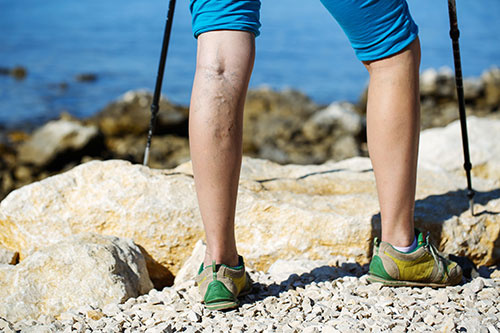After reading the last article, I looked more into chronic venous insufficiency. While browsing online, I read an article that claims venous insufficiency symptoms can actually predict thrombosis for the elderly. Is this true? I’m concerned since my aunt is exhibiting symptoms and is also elderly.
–Tim from Killen
It is true that some symptoms of Chronic Venous Insufficiency (CVI) can be indicators of a more serious problem – specifically venous thrombosis, which is a blood clot that forms within the veins.
Varicose veins (also known as “spider veins”), leg ulcers, leg edema, and reduced blood flow are common symptoms of CVI which can also double as risk factors of venous thrombosis. This condition usually occurs in people who are 70 years or older; in fact, 60% of cases occur in this demographic.

According to a study performed concurrently in the U.S. and in the Netherlands, researchers found that venous thrombosis could develop either with or without pulmonary embolism, which is a sudden blockage in a lung artery that is usually caused by a blood clot that forms in the leg and travels through the bloodstream to the lung.
In the study, venous thrombosis occurred in patients with varicose veins 1.6-fold, in patients with leg ulcers 3.3-fold, and in patients with leg edema 3-fold. Researchers also found that the highest risk for thrombosis occurred when patients exhibited all three of these symptoms simultaneously. Venous thrombosis alone developed in 41% of patients, and pulmonary embolism with or without thrombosis developed in 59% of patients.
Since Chronic Venous Insufficiency is a major indicator of venous thrombosis, it is important to identify any cases of CVI as soon as possible. So what are some telltale signs of CVI?
Signs of Chronic Venous Insufficiency
CVI is associated with varicose veins and commonly develops in people who stand or sit for long periods of time. Some symptoms of CVI include:
- Swelling in the legs and feet at night (which decreases by morning)
- Thickened toenails
- Hair loss on the feet
- Aching or heaviness in the legs
- Itching, tickling, or swelling
- Cramping in the legs at night or while resting
- Reduced pain in the morning or while standing
- Skin color changes around the ankles
- The appearance of “spider veins”
CVI occurs when the walls and/or the valves in the leg veins are not working effectively, making it difficult for blood to return to the heart. This condition causes blood to “pool” or collect in the veins. People who experience CVI often complain that long car trips are difficult since the heaviness, cramping, and swelling in their feet is painful.
The main way to diagnose CVI is to undergo a Doppler venous evaluation with a cardiovascular specialist. A cardiovascular specialist can also recommend compression stockings or perform laser ablation to treat this condition.
If you want more information regarding CVI or venous thrombosis, call the Cardiovascular Institute of the Shoals at 256-766-2310 to schedule an appointment.
